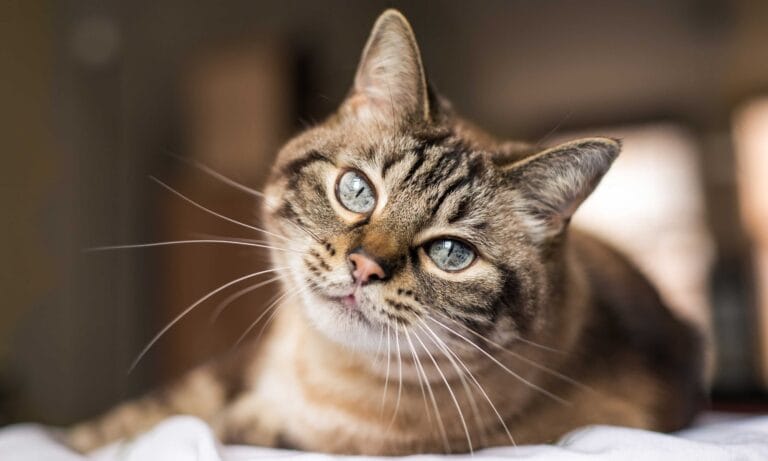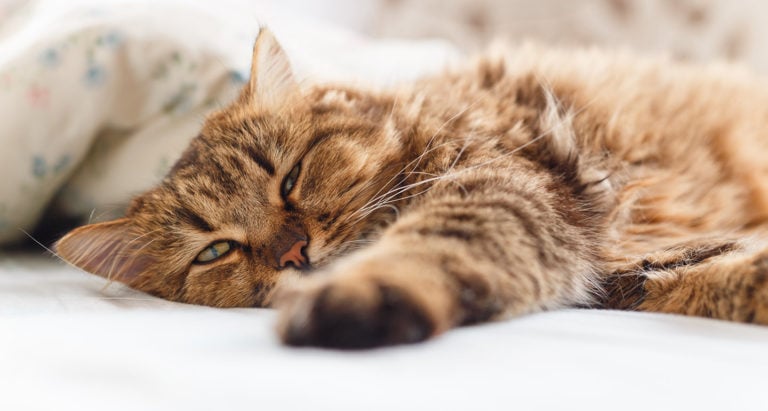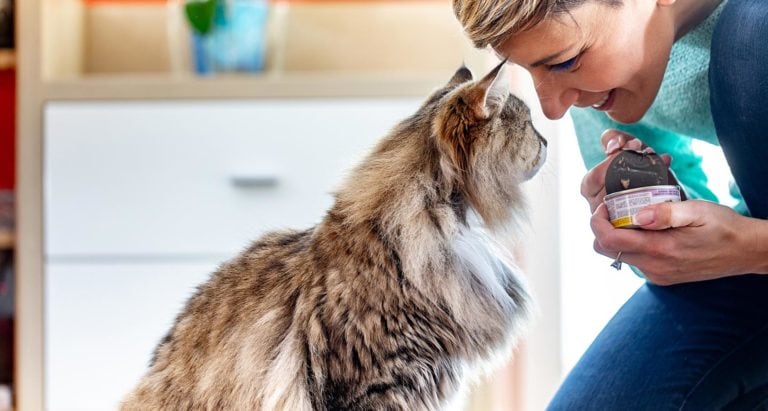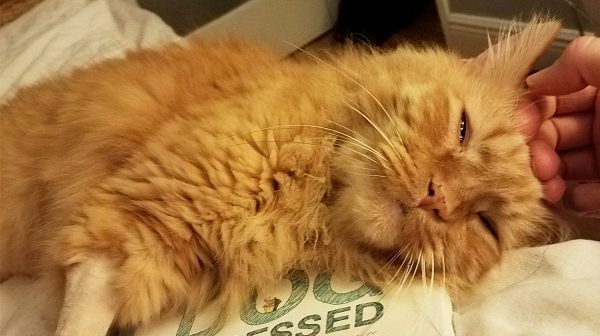Patches lay on her side on my exam room table, clearly struggling to breathe. We could even hear her breathing from outside the exam room. Taking a look at her, I could see her entire belly heaving with each and every breath, mouth held open wide, with a loud, rhythmic wheezing noise. She was clearly distressed, but it was difficult to tell who was more upset — owner or patient. Mrs. Lamarre had called earlier that day, frantically stating that Patches had started having trouble breathing all of a sudden, and letting us know that she was on her way down with her.
Respiratory problems are very common in cats, and particularly in old cats. Much like with people, ANY trouble breathing is something we consider significant. Across the board, I recommend an examination to determine the underlying problem. However, a little detective work by you will absolutely be helpful to your veterinarian in working through the process.
What Is Wheezing?
Many owners use the phrase “wheezing” to describe any noise that appears to come from the airway; however, the word has a very specific medical meaning associated with it. Wheezing is a high-pitched airway sound that is usually produced while the patient is exhaling. The cause of the wheeze is a narrowing of the airways, which traps air into the lungs. The sound you hear is the air being forced out of the lower airways and through these narrow tubes. In most instances, a wheeze indicates a lower airway problem (such as the bronchi and lungs), as opposed to an upper airway problem (such as the nose and pharynx).
What Is Not Wheezing?
Many other noises can be confused with wheezing.
1.Whistling: A high-pitched whistle is a very common sound from cats sufferings from congestion. However, this sound can occur with inspiration (inhaling), expiration (exhaling) or both. Many cats, particularly if they go outside, are exposed to a large number of other cats or are not vaccinated, can develop respiratory infections that result in congestion and respiratory noise. But often in such cases the cats have other signs of illness, such as sneezing, ocular or nasal discharge, or coughing.
2. Stertor And Stridor: Less common are noises that we call stertor and stridor — both of which occasionally happen in cats. Stertor is a heavy snoring sound occurring primarily during inspiration and is most commonly noticed during deep sleep. This sound is usually normal, but could indicate an obstruction of the larynx or upper airways. In cats, it is usually noticed in a younger cat with polyps, but sometimes is seen in obese older cats as well. Stridor is a high-pitched and noisy sound that can occur during either exhalation or inhalation, and is usually caused by a respiratory obstruction. In cats, it has a variety of causes including foreign bodies in the airway and bacterial infections.
3. Dyspnea: Another airway symptom is something we call dyspnea, or difficulty breathing. This can occur with inspiration, expiration or both — but it generally occurs when the animal is really laboring to breathe. This indicates a lower airway problem, and veterinarians generally race into action looking for the cause. Two very common causes of this are pneumonia and heart failure. Confused by all of the choices yet? Don’t worry, that is why you have a veterinarian! However, even if the details are difficult to understand, there are some very basic points to grasp about respiratory disease in cats.
Signs Of Respiratory Trouble In Cats
I always take respiratory disease seriously in cats, and always recommend an examination to look for the underlying causes. Signs that your cat needs to be seen immediately include:
1. Any cat who has an increased respiratory rate. A healthy cat normally takes between 20 and 30 breaths per minute. If your cat is breathing faster than that (especially at rest), do not hesitate to take her to the veterinarian.
2. Any cat who is breathing with her mouth open is an emergency case. Do not even stop to take a respiratory rate. Take your cat to the nearest veterinary hospital whether it is 2 a.m. or 2 p.m. Cats generally do not pant like dogs and we worry about any pet that is open-mouthed breathing. This could be life-threatening.
3. Any cat who is suddenly making a new respiratory noise, is awake and appears in any way distressed (sides are pushing, respiratory rate is increased, or mouth is open) should be seen by a veterinarian immediately.
Ways To Help Your Veterinarian Diagnose Your Cat
If you have the luxury of time, you can help your veterinarian determine what’s causing your cat’s breathing trouble.
1. Observe Your Cat: Try to determine whether the noise you are hearing happens when the cat is breathing in (inspiratory), breathing out (expiratory) or both. This will help your veterinarian to localize the problem.
2. Record Your Cat: If you have the ability to record what you are seeing, do so, and take the video with you to the veterinarian. Seeing the problem in action is worth a thousand words.
3. Keep Track: Count the number of breaths your cat takes within a minute’s time. When she is frightened in the hospital, it can be difficult for us to get an accurate respiratory rate, so a resting rate at home can be very helpful.
4. Note Other Signs: Lastly, note any other changes — nasal discharge, sides heaving, anything that seems different. Take all of this data with you to your appointment: That will help your veterinarian make choices in their recommendations.
Diagnosing Wheezing
What is likely to happen at your veterinary visit? If the noise is upper airway, mild or just congestion, your veterinarian may choose to treat your cat with some medications to try and resolve the problem. However, if the problem is severe, brace yourself for your veterinarian to go into full gear — as I believe they should.
Many of these cats need to rest in an oxygen cage (breathing close to 100 percent oxygen, as opposed to the fraction of oxygen present in room air) for an hour or more before an exam can even be safely done. Most commonly, a combination of radiographs (X-rays) and blood tests are needed, especially in sick cats. Unfortunately, this has the potential to be such a severe situation (imagine how panicked you would be if you couldn’t breathe!) that it is necessary to “pull out all the stops” to get information.
Common Causes Of Wheezing In Old Cats
What is your veterinarian looking for? The most common worry in old cats is asthma. Fortunately, this is very treatable. The next common concern on the list is heart disease, often linked to thyroid disease in the older cats. Luckily, these are also treatable conditions. Next on the list includes things like heartworm disease, tumors, fluid around the lungs and pneumonia. The prognosis for a cat depends on the final diagnosis.
Long story short, don’t panic, but act swiftly and decisively, get some answers, and then make an educated decision for your cat. Time is critical with respiratory problems.
One Cat’s Outcome
So, what became of little Patches? After she had some time to relax in our oxygen cage, we did some additional testing and discovered that she had heartworm disease. Although heartworm is uncommon in Maine, it does still happen. And we wouldn’t have known if we didn’t look! Lucky little Patches is back home again, and feeling much better — thanks to the swift action of her owner.
Dr. Sandra Mitchell is a 1995 graduate of the New York State College of Veterinary Medicine at Cornell University. She is a board certified diplomat of the American Board of Veterinary Practitioners for both Feline Practice and Exotic Companion Mammal Practice. She owns and works full time at Animal Medical Associates, in Saco, ME, and serves as a veterinary consultant and continuing education instructor for the Veterinary Information Network (VIN).
Featured Image: Burkhardt-Mayer-Fotografie GbR/iStock/Thinkstock
Share:









